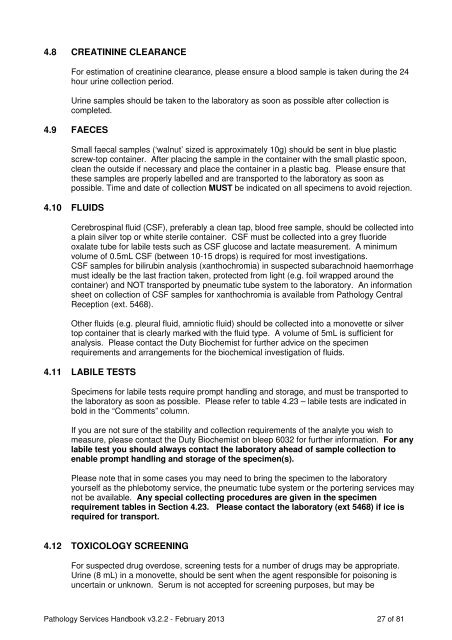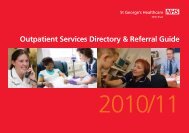pathology services handbook - St George's Healthcare NHS Trust
pathology services handbook - St George's Healthcare NHS Trust
pathology services handbook - St George's Healthcare NHS Trust
Create successful ePaper yourself
Turn your PDF publications into a flip-book with our unique Google optimized e-Paper software.
4.8 CREATININE CLEARANCE<br />
For estimation of creatinine clearance, please ensure a blood sample is taken during the 24<br />
hour urine collection period.<br />
Urine samples should be taken to the laboratory as soon as possible after collection is<br />
completed.<br />
4.9 FAECES<br />
Small faecal samples (‘walnut’ sized is approximately 10g) should be sent in blue plastic<br />
screw-top container. After placing the sample in the container with the small plastic spoon,<br />
clean the outside if necessary and place the container in a plastic bag. Please ensure that<br />
these samples are properly labelled and are transported to the laboratory as soon as<br />
possible. Time and date of collection MUST be indicated on all specimens to avoid rejection.<br />
4.10 FLUIDS<br />
Cerebrospinal fluid (CSF), preferably a clean tap, blood free sample, should be collected into<br />
a plain silver top or white sterile container. CSF must be collected into a grey fluoride<br />
oxalate tube for labile tests such as CSF glucose and lactate measurement. A minimum<br />
volume of 0.5mL CSF (between 10-15 drops) is required for most investigations.<br />
CSF samples for bilirubin analysis (xanthochromia) in suspected subarachnoid haemorrhage<br />
must ideally be the last fraction taken, protected from light (e.g. foil wrapped around the<br />
container) and NOT transported by pneumatic tube system to the laboratory. An information<br />
sheet on collection of CSF samples for xanthochromia is available from Pathology Central<br />
Reception (ext. 5468).<br />
Other fluids (e.g. pleural fluid, amniotic fluid) should be collected into a monovette or silver<br />
top container that is clearly marked with the fluid type. A volume of 5mL is sufficient for<br />
analysis. Please contact the Duty Biochemist for further advice on the specimen<br />
requirements and arrangements for the biochemical investigation of fluids.<br />
4.11 LABILE TESTS<br />
Specimens for labile tests require prompt handling and storage, and must be transported to<br />
the laboratory as soon as possible. Please refer to table 4.23 – labile tests are indicated in<br />
bold in the “Comments” column.<br />
If you are not sure of the stability and collection requirements of the analyte you wish to<br />
measure, please contact the Duty Biochemist on bleep 6032 for further information. For any<br />
labile test you should always contact the laboratory ahead of sample collection to<br />
enable prompt handling and storage of the specimen(s).<br />
Please note that in some cases you may need to bring the specimen to the laboratory<br />
yourself as the phlebotomy service, the pneumatic tube system or the portering <strong>services</strong> may<br />
not be available. Any special collecting procedures are given in the specimen<br />
requirement tables in Section 4.23. Please contact the laboratory (ext 5468) if ice is<br />
required for transport.<br />
4.12 TOXICOLOGY SCREENING<br />
For suspected drug overdose, screening tests for a number of drugs may be appropriate.<br />
Urine (8 mL) in a monovette, should be sent when the agent responsible for poisoning is<br />
uncertain or unknown. Serum is not accepted for screening purposes, but may be<br />
Pathology Services Handbook v3.2.2 - February 2013 27 of 81





